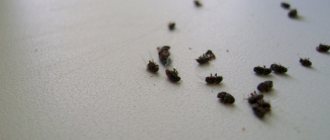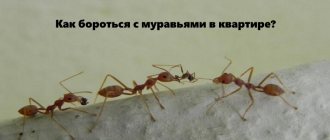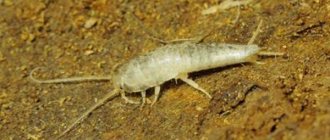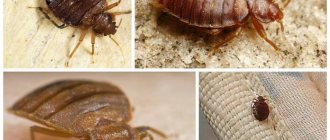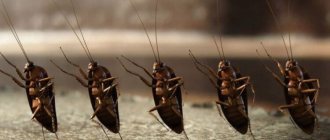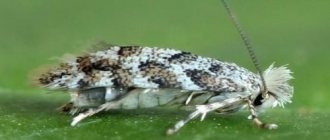- Insecticides
Damaged carpets, furniture, clothes and other household items are the main reason that motivates you to look for an answer to the question of how to get rid of skin beetles in an apartment. Small insects are almost invisible to the human eye, but can cause significant damage to households and are dangerous to human health. You can save things and protect yourself by using an integrated approach to solving the problem. Chemical control methods, folk remedies and compliance with preventive measures can help with this.
The carpet beetle poses a danger to things and human health. To prevent adverse consequences, it is important to begin pest control as early as possible, using available methods and means.
The article contains effective methods that will help get rid of pests and prevent their occurrence in the future. To achieve maximum effect, use several methods in combination.
Small brown bug in the apartment - what kind of insect?
This small brown bug in the apartment is called the skin beetle. Its wide habitat is due to its omnivorous nature and rapid reproduction and movement. Under natural conditions, the adult along with the larvae are able to consume almost any organic food.
According to coleopterologists, the most favorable living conditions are considered to be tree hollows, bird nests, forests and swamps: almost throughout the entire territory of the central zone. The reason for the appearance of bugs in apartments is the lack of food in natural conditions.
Little brown bug on the windowsill
One of the first places where it can be found is the windowsill. The main reasons for their appearance in this place are:
- the ability to fly freely from place to place;
- lay the larvae on the back side of the windowsill;
- the presence of favorable conditions for reproduction (especially if there are heating radiators in these places).
Flying little brown bug
They successfully migrate into human homes. A flying little brown bug is able to move into a residential area using clothing and personal belongings. Thanks to their mobility, they can independently penetrate windows and doors.
Thanks to its good ability to reproduce and excellent camouflage characteristics (small size and color), it quickly spreads throughout the apartment.
Let's celebrate! After entering the apartment, they begin active reproduction and within three weeks after laying eggs, red-colored caterpillars hatch. Each female is capable of laying eggs for two to ten days. In total, up to one hundred eggs are obtained. After this, the adults die.
Folk remedies in the fight against skin beetles
You can fight bugs with folk remedies. For example, using plants with a pronounced aroma - sage and lavender. Place the branches in potentially dangerous places, and place cotton pads soaked in essential oils in the closet. Bright aromas are guaranteed to scare away skin beetles.
Insects are repelled by the scents of lavender and sage. Use them to get rid of skin beetles and prevent their appearance.
Insects are very susceptible to temperature changes, and this feature can be used against them. In winter, take the affected products outside and leave them in the cold for 24-48 hours. You can similarly put clothes in the freezer, but this method only allows you to process one or two items at a time. In winter, open all windows to freeze out insects. After airing, vacuum the room and carry out wet cleaning.
High temperatures, such as steam treatment, will help quickly destroy pests. This method of exposure destroys insects at different stages of development - eggs, larvae, adults. The disadvantage of this method is the impossibility of carrying out full treatment throughout the entire room, so it should be combined with other approaches.
A table bite will help get rid of carpet beetles: dissolve 1 tbsp in 1 liter of water. l. facilities. Spray the resulting composition from a spray bottle in insect habitats. To kill pests on the windowsill, baseboard or shelves, wipe the surfaces with a cloth soaked in the solution.
If there are a lot of skin beetles in your apartment and the described control methods do not bring results, seek help from disinfectants. Specialists will clear the area and get rid of beetles at different stages of development.
Reasons for the appearance of bugs
The reasons for the appearance of bugs can be both external and internal factors.
External factors include:
- reduction of the nutrient medium in natural conditions;
- changes in climatic conditions (decrease in temperature and increase in humidity);
- ability to move long distances.
Internal factors can be:
- presence of a nutrient medium in the room;
- comfortable conditions for living and reproduction;
- placing stuffed animals or birds in the apartment;
- storage of a collection of insects (beetles, butterflies);
- home library (especially if you have old tomes);
- presence of pets (especially long-haired ones);
- neglect of preventive measures to combat the skin beetle.
Good to know! The summation of internal and external causes leads to the rapid spread of this pest in residential areas.
How the leather beetle gets into human housing
In warm weather, bugs secretly penetrate into the apartment, where it is often trashy and dirty:
- They fly into an open window or window;
- Hiding in purchased furniture from an infected room, clothes and shoes;
- With indoor plants or on a bouquet;
- Brought in by shoes or clothes when coming from the street;
- Food contaminated with larvae is brought into the apartment;
- They will crawl from the balcony, use cracks, ventilation or garbage chutes.
Who are skin beetles?
Specialist coleopterologists classify this small insect as a member of the order Coleoptera. It has a brown sometimes black color. The insect is small oval in shape. The entire body is covered with short, stiff hairs.
Brown beetles are divided into four large classes, each of which contains from two to eight species. According to this classification, there are more than 600 species.
Types of bugs, what do they eat?
The following types are most common in apartments:
- ham (the most common is almost black in color);
- carpet (uses organic compounds);
- fur coat (has a black color with several white dots on it. Prefers crumbs, food scraps, table waste. The adult lives using accumulated nutrients);
- Kozheed Smirnova (brown in color. Settles in wooden structures: door and window frames, wooden floors and wall decoration, in furniture elements);
Any household items serve as a breeding ground for them: from organic compounds (leather goods, fabrics, books, furniture, carpets, waste products) to synthetics.
The diet includes: cardboard, felt, rubber, cable braid, asbestos structures. Capable of eating indoor plants and flowers. They can cope with almost all plant foods.
The grain beetle is capable of destroying nuts. Various types of grains and cereals, bran flour and products made from them. Ham specializes in meat and fish products.
Let's celebrate! Despite this omnivorous nature, small brown bugs are able to go without food for a long time. It has been established that this period can last up to five years. In this case, their biological processes slow down, but they remain viable.
Brown bugs on the windowsill - what are they called?
When we talk about “small” bugs, we most often mean bugs the size of a match head, or even smaller. Several hundred pests fit this description. But in houses and apartments, 2 types are most often found:
- Carpet beetle.
- Grinder.
It is believed that the first one starts due to dust, a large number of old things in the house, carpets, and the second one feeds on flour and cereals. They end up on the windowsill, like many other insects, by flying into the light. In the evening, the bugs move into the ceiling lamps, where they often die.
Carpet beetle
The pest is very common in private homes, but can also live in apartments. He was nicknamed the Kozheeder for his passion for leather goods, and in particular, for museum stuffed animals. He is not interested in human skin. In general, the bug is almost omnivorous. He eagerly eats bread crumbs, nuts, fur products, carpets, books, and wood. There are known cases where skin beetles have gnawed through plastic, asbestos, the walls of buildings, eaten stocks of beans, grain, meat, dried mushrooms and spices, and damaged agricultural vehicles.
You can recognize the skin beetle by its characteristic hard oval back. In appearance it looks like a ladybug, only dark brown or black, and very small. The length of the body does not exceed 3 mm, and a tail-tassel is visible at the tip. If you look at the bug through a magnifying glass, you will notice tiny hairs on the back.
Skin beetles have rather large and mobile larvae, about 2 mm in size. They hide mainly in dry, warm and dark corners, in accumulations of dust. A new individual hatches, on average, after 2 months. But beetle eggs in favorable conditions can survive up to 5 years.
Photo of the skin beetle:
Another notable feature of the skin beetle is its manner of movement. They prefer to slowly crawl, and at any touch they instantly roll over with their belly up, as if dead. Skin beetles can also fly, and if you crash into a person, the collision is very noticeable due to the rigidity of the bug.
Kinds
There are about 700 varieties of skin beetles. In nature, these insects process dust, feathers, wool and bones of dead birds and animals. In the absence of a natural source of food, 7 species of skin beetles live in apartments and houses:
- Ham. Well recognizable due to its characteristic color. The beetle is oblong, with a black head and lower elytra. A light gray stripe with black dots runs across the back. Body length can reach 7-8 mm. The bug prefers food of animal origin (meat and bone meal); it can eat leather and fur products, and cereals. Photo of ham skin beetle:
- Brownie. A small motley bug measuring 2-3 mm damages wool, felt, and less often meat products. Its back is covered with light gray and brown spots. Photo of the house beetle:
- Museum. In appearance and color it is similar to the house leather beetle, but is much darker. It is a dangerous pest of museum exhibits. In apartments and houses it feeds mainly on dead insects, the remains of egg capsules, cocoons, etc. What does a museum leather beetle look like:
- Carpet. It is distinguished by its coal-black color, but its antennae and paws are black. The carpet beetle is an omnivore, but prefers to feast on products made of wool and down: carpets, pillows, blankets, coats. Photo of the bug and larva:
- Fur coat. Capable of quickly destroying products made from natural wool and down. It differs from the carpet beetle in its elongated body shape and the presence of 3 small white spots on the back. The color of the bug is brown-black, the back looks like velvet. Photo:
- Grain. It eats grain and often affects warehouses where it is stored. Can destroy up to 70% of stocks in a few months. The bug has a light brown color, reddish hairs, legs and antennae. This is what it looks like:
- Kozheed Smirnova. The most common species in Russia. Smirnov's Kozheed has adapted almost as well to life near humans as cockroaches. It is omnivorous, the larvae eat the felt backing of linoleum, pet hair, dust, and food. Adults do not feed, but live off the reserves accumulated during the larval stage. The bug is brown in color. Photos close up:
Grinder
The borer beetle in nature settles in decaying wood - in stumps, dying trees, etc. The length of the insect's body ranges from 5 mm to 1-1.5 cm. The larvae of the borer are white or white-yellow, large, curved, shaped like a letter "WITH". They have well-developed legs with claws and a large head with reddish pubescence.
The grinder beetle is popularly known as the “death clock.” Moving through holes in the wood, it makes a characteristic sound. People have noticed that after the “ticking” appears, the house collapses within several years. The bug is predominantly nocturnal.
Over the years, grinders have learned to coexist with humans, and their diet has become more varied. Some bugs “specialize” in cereals, others in wallpaper glue, books, garbage, furniture, etc. Grinders are active from May to October. Photo:
Kinds
There are about 1,500 subspecies of grinders, but in the house on the windowsill you can most often find:
- Bread grinder. The bug, 1.5-4 mm in size, is brown in color and eats mainly cereals, cookies, pasta, flour, dried fruits, confectionery and spices. Grinders themselves are rarely found in products. Their milky-white oval eggs and larvae, which resemble thick worms, live there. Photo:
- Furniture sharpener. It parasitizes dry wood of any species. Gnawing holes in floors, windows, walls. The color of the bug is brown, on the back there are stripes that consist of many dots. Photo:
Pest danger to humans
The troubles associated with the proximity of a small brown bug for a person are associated with the manifestation of the following negative consequences:
- consequences of a painful bite especially for children and women;
- manifestation of an allergic reaction in people prone to this disease;
- transfer of pathogenic viruses, for example infection by helminths (due to larvae feeding on the remains of plant and animal food);
- deterioration of expensive and beloved things.
Despite its small size, the bite of a brown bug is quite painful. Each person has their own reaction to such bites. It can cause redness and subsequent inflammation at the bite site. During a bite, pathogenic bacteria can enter the wound and cause infection not only of the bite site, but of the entire body.
Therefore, doctors strongly recommend treating with a disinfectant after detection. This could be hydrogen peroxide, iodine or brilliant green.
Let's celebrate! Untimely treatment can cause an inflammatory process, which only a professional physician can help cope with and self-medication will not help.
How does the skin beetle reproduce and develop?
The development of the larva to an adult insect lasts 12 months.
The female beetle lays eggs in cracks and on top of objects 5 times a year, over 100 eggs in a lifetime. The larvae hatch in 2-50 days, this is influenced by dry air and temperature - the warmer and drier, the sooner the appearance.
The larva molts 6-7 times in 5-9 days, then becomes a pupa, from which an adult insect emerges. This takes 60-90 days. Before pupation, the larvae gnaw out 10 cm labyrinthine passages in inedible objects.
It is interesting that with the onset of unfavorable conditions, the larvae fall into torpor for up to 4 years, and upon emergence they continue to develop. Adult beetles can spend the same amount of time without feeding and still reproduce.
How to get rid of bugs in an apartment?
To get rid of these neighbors you need to have answers to the following questions:
- How did they get into the living space?
- Where might they be?
- Features of their behavior?
- By what means is it advisable to get rid of them?
The first question can be quite difficult to answer. Small brown bugs can enter your home by flying into an open window or door. They can be brought on clothes, plants or mushrooms from the forest, or received as a gift along with purchased furniture.
The second question may be easier to answer, because the favorite places of residence of this pest are known.
These include:
- in the wool of carpets and carpet runners;
- on clothes (especially fur, wool, cotton);
- in niches behind radiators;
- on the bottom of the window sill (especially if it is wooden);
- under door frames and floor skirting boards;
- in upholstery of upholstered furniture;
- in food products (cereals, flour, meat and fish).
Therefore, in order to find the habitat, it is necessary to conduct a thorough check of such places.
To solve this problem faster, it is necessary to know the peculiarities of their behavior.
These include:
- beetle larvae are always found in dark places and cannot tolerate any light;
- adult bugs fly in daylight (sometimes it is possible to lure them into the light of apartment lighting);
- all leather beetles do not tolerate high humidity;
- they are not able to tolerate low temperatures.
The peculiarities of their behavior make it possible to quickly detect them and choose the most effective methods of control.
When choosing products to combat skin beetles, you can use the following methods:
- mechanical;
- physical;
- chemical.
Cleaning
The first method involves mechanical destruction of adults and their larvae. After finding the habitat, all insects found are mechanically destroyed. To increase the destruction area, you can use a vacuum cleaner, mop or other utility tool.
Freezing the premises
Physical methods involve changing the state of the physical environment. Knowing that bugs cannot tolerate low temperatures, you can carry out the procedure of freezing the room in winter. This will lead to the death of the entire population. Household steam generators have proven themselves well.
Disinsection of premises
The chemical method involves the use of products developed by the chemical industry to kill pests.
Usually they try to produce universal means for exterminating an entire class of pests. However, such drugs lose their versatility. The most appropriate is the use of narrowly targeted means.
Such preparations are created on the basis of hydrogen phosphorous or phosphine. They are used under synthetic film or indoors. This fumigation is quite effective. It involves subsequent ventilation, collection of dead pests and their removal.
Contact insecticides have shown good effectiveness. They are applied to the detected accumulation of brown bugs. Modern industry offers a wide range of such pesticides. Before using them, it is necessary to obtain specialist advice.
The most widely used drugs are:
- Group of insecticides.
- Boric acid.
- Traps containing a sticky chemical.
- Various tablets (for example, from the Antimol category).
Destruction of furniture
The most radical way to combat infested pests is to destroy old furniture. This is due to the difficulties associated with eradicating an entire population. Their ability to remain without food for a long time allows them to survive the most active chemical attack.
Why do they appear?
These bugs can be seen everywhere:
- Under the baseboards.
- In places where bulk products are stored.
- In closets with clothes.
- Behind the radiators of the heating system.
- In carpets and runners.
- On indoor ornamental plants.
- Inside various furniture.
- Close to heating appliances.
- On the windowsills.
- In places where smoked and dried products, including meat, are stored.
- In areas where grains or peanuts are stored.
- Among the waste paper.
The larvae of carpet beetles are quite tenacious compared to adult beetles. They can live without food for several weeks. In places where it is dry, including behind baseboards, in corners, and also near the back wall of a furniture cabinet, all conditions for normal life have been created for them. Sunlight does not penetrate into such places, which creates comfortable conditions for these insects.
How do insects enter a person’s home?
There are many ways for such insects to enter an apartment or house. For example:
- Through open doors, windows and vents, if they are not protected by anything.
- With purchased or donated old books or furniture.
- With used items, if they were purchased secondhand.
- Inside the products if they were not stored correctly.
- With grains or cereals.
- With dried foods bought at the supermarket.
- From attics and basements, unless special services are watching them.
- With dried mushrooms or dried fruits, as well as medicinal herbs purchased at the market.
- With old carpets, also bought secondhand.
It is quite difficult to somehow prevent the appearance of these pests due to their small size. Since they are difficult to notice even upon inspection, since their brown color allows them to camouflage, they easily penetrate into a person’s home.
Preventative measures for brown bugs
To eliminate brown bugs, it is necessary to carry out extermination and preventive measures.
Such activities are expected to include:
- Carrying out periodic checks for the presence of brown bugs;
- Constant ventilation, especially in winter, with the temperature in the room dropping to 12 degrees;
- Sealing of residential premises, eliminating cracks and possible entry points for pests;
- periodic wet cleaning of premises using special products.
Good to know! Controlling such pests is quite difficult. This is due to their small size, high vitality and omnivorous nature. However, the use of preventive measures, periodic inspection of possible places where pests accumulate and carrying out all methods of destruction will prevent the settlement and spread of small brown bugs.
Methods of disposal
You can eliminate such a problem as beetles living on the windowsill or elsewhere in the apartment without resorting to expensive chemicals. It is enough to discover the breeding ground and get rid of it.
You should move all the furniture and carefully inspect it for cracks, crevices, and rotten areas. Next, you need to go through all the books, and especially old copies. Conduct an audit of products: cereals, flour, crackers, dried fruits, etc.
Small bark beetles love sweets the most, so you should check there first.
Once an insect nest has been discovered, it should be eliminated along with spoiled food. Cereals, dried fruits, flour, etc. must be thrown away immediately. If bugs are found in furniture, the damaged area must be thoroughly cleaned of debris and treated with a special wood protection agent. It is also better to get rid of books or bake them in the sun if they are of value.
To eliminate pests, you can also use chemicals, for example, boric acid, which should be rubbed into the affected areas. There are other substances sold in stores in the form of sprays, aerosols, gels, etc. The procedure should be repeated several times a month, and the treated areas should be washed a day after each manipulation.
Preventive measures
Carpet beetles spoil not only furniture, but also food. To prevent their occurrence, it is necessary to adhere to preventive measures. We urgently need to get rid of the bugs. Experts recommend regularly inspecting your home for insect infestation. It is necessary to carry out sanitary control in all premises. Maintaining optimal temperature conditions allows you to prevent the colonization of beetles in the house.
Preventive measures include proper sealing of rooms, door and window openings. Carpet beetles love to enter a room through all sorts of cracks, cracks, and holes. They lead a hidden lifestyle. Tight sealing prevents pests from entering the house. It is also necessary to carry out regular wet and dry cleaning in the apartment (house). It should be carried out using a vacuum cleaner, cleaning agents, and disinfectants. old unused items made of wool, leather and fur should be thrown away.
It is important to know! If the room temperature is below 12 degrees, skin beetles die completely.
Domestic skin beetles can cause great harm not only to your home, but also to your body. Carpet beetles can settle in various places, including food and cereals. If the excrement of small bugs gets into the body along with food, it can cause digestive system upset, an allergic reaction, choking, and coughing. Insect bites may cause skin itching, redness, and a small rash.
Existing risk factors for humans
If skin beetles have settled in an apartment, they carry with them a lot of negative consequences. Small bugs can bite painfully. The bites are painful for women and small children due to their delicate, thin skin. Insect bites can trigger allergic reactions and skin irritations, which can lead to psoriasis. Skin beetles are carriers of diseases. Insect waste can enter the human body along with food. This can cause disruptions in the functioning of the body. A cough, asthmatic attacks, stomach pain, asthma attacks, redness of the skin, a small rash, and diarrhea may appear.
Damage caused by insects in the home
What harm do they cause?
- The fur species damages fur products by gnawing holes in them. In clothing wardrobes they make egg clutches, from which larvae emerge that eat any fabric;
- The food variety of these beetles, which eat cereals, spoils bulk products. They infect kitchen cabinets from the inside and multiply rapidly. If you find insects in cereals, flour or sugar, then these products are no longer suitable for food and must be disposed of immediately;
- house leather beetle spoils furniture, carpets, and wooden objects. They render furniture completely unusable both outside and inside.
Along with such bugs, larger individuals can enter the house, for example, black cockroaches up to 3 cm in length, which should be gotten rid of immediately by any means. A wooden house may have a bark beetle that eats the wood. Therefore, before thinking about what means to fight, you need to determine what kind of insect has settled in your home.
Review of the best products
Given the wide range of modern insect control products, it is often extremely difficult to make a choice.
To make this process as easy as possible, below is a brief overview of the most effective options:
Aerosol Combat
Containing insecticides such as permethrin and tetramethrin, it is one of the most well-known and effective remedies for home use. It allows you to destroy all types of crawling insects and arthropods, while being able to poison even their eggs and larvae. Combat does not have a pungent chemical odor; instead, a pleasant floral aroma will remain on the treated surfaces. The cost of a can with a volume of 500 ml is about 400 rubles.
Aerosol "Raptor"
It costs less than Combat, but is no less effective. Available in 350 ml cans, the approximate cost is 250 rubles.
Get insecticidal soap
Effectively gets rid of ants, bedbugs and cockroaches. You can even treat carpets with it; the product can then be easily washed off and will not leave stains behind. The approximate price of such soap is 400-420 rubles.
Avalon product
It is an emulsion concentrate from a South Korean manufacturer. The main advantage is the versatility of the solution obtained from it, which destroys all crawling and flying insects and provides protection against them for several weeks. The cost of one 50 ml bottle is about 600 rubles.
Foresight tool
It is also an emulsion concentrate, the main active components of which are cypermethrin and fenthion. First of all, the drug is intended to kill ticks, but it also shows good effectiveness against other crawling insects. The price for it is 350-400 rubles.
Means "Xulat"
Made in Spain, it is intended for preparing a solution based on it. The composition includes various insecticides, which allows you to destroy even insects with developed immunity to certain components. A 30 ml bottle costs about 500 rubles.
Product "Delta Zone"
It is one of the most effective modern remedies, the main active ingredient of which is deltamethrin. A solution based on it shows equally good results in exterminating all types of flying and crawling pests. The cost of a 50 ml bottle is about 700 rubles.
Aerosol "Super Cobra"
Against crawling insects, its quality and effectiveness is confirmed by the fact that it is used by many service specialists for the destruction of these pests. The cost of one bottle is about 230 rubles.
Cucaracha
It is a concentrated liquid preparation that is capable of exterminating all types of insects. The rules for preparing a solution based on it are indicated in the instructions for the product and vary depending on the type of pests being controlled. The price of one bottle is 450 rubles.
Devices emitting ultrasonic waves
They are the most innovative devices for fighting insects. The Belgian-made Weitech WK0523 model, among other things, also affects rodents. The package includes three devices that can be placed in different rooms to increase the area covered by the protective effect. The cost of this equipment is about 4,000 rubles.
Types of insect repellents
To combat unwanted neighbors, people have developed a large number of different means that have different principles of action.
All the most common varieties are discussed below:
- Products produced in gel form. have high
effective because they contain aromatic components that attract the attention of pests, and insecticides that have a poisonous effect on them. Gels can infect insects both when they enter the digestive system and through direct contact. However, they do not have any foreign odors, and most options are safe for children and pets. - Aerosol is one of the most effective ways to destroy unwanted neighbors. Such products kill pests faster than many analogues, since poisonous and toxic substances enter their body through the respiratory system. To date, a large number of universal preparations or aerosols have been developed for the extermination of certain species.
- Various types of traps that can catch living individuals or destroy their captives. The most common models are those with an adhesive backing; if an insect steps on it, it loses the ability to move. Sticky strips can be suspended from the ceiling to help effectively catch flying species. Another well-known trap is a small house with poisoned bait inside. The pest, having been poisoned by an insecticide, infects its relatives upon contact with them, but such models are effective only against crawling species. An innovative way of combating is the use of universal electric traps, which are equally successful in destroying all species. Death occurs as a result of receiving an electrical discharge, the strength of which is safe for humans.
- Folk remedies that abound with various recipes for exterminating household pests. Typically, such methods are time-tested and therefore do not lose their relevance today, even with so many modern drugs and devices.
- Various solutions and liquid insecticides. Usually they are diluted with water in accordance with the instructions, after which the premises are treated. There are a large number of substances with varying degrees of toxicity and intended for different types of pests.
Reproduction process
Carpet beetles reproduce quite actively. During the period of life, for the first and subsequent times, the female is capable of hatching from ten to several hundred eggs. The female prefers to lay eggs in fleecy things, on woolen surfaces, in bedding, in stuffed animals, and upholstered furniture. After the eggs have been laid, the female dies. The incubation period for the development and maturation of eggs ranges from 2 to 55 days on average. The development of eggs depends on the temperature in the room. After they mature, the eggs hatch into larvae. They can mature into adults in up to 2 years.
It is important to know! An unfavorable environment for larvae is low temperature, dampness, and bright light. Favorable conditions include optimal room temperature, dim light, and low air humidity.
Routes of penetration
When small bugs appear in the house, everyone wonders where they came from.
Carpet beetles can enter an apartment from an infested room on clothes, shoes or in a person’s bag. Sometimes they come from neighbors through small cracks near pipelines, ventilation holes, open windows or entrance doors. If you see a bug on the windows, you should not ignore it. We need to figure out where she came from and whether there are any of her brothers in the house.
The food-eating beetle and bread grinder beetle can be brought from the store along with the cereal. This happens if the rules for storing and processing products are violated in warehouses or granaries.
Bread grinder
Infestation of a wooden house by insects that spoil wood often occurs at the stage of procurement of building material. They can also be brought in old furniture or brought in with boards during renovation. If such bugs begin to crawl around the apartment, you need to check not only wooden products, but also the floor, baseboards, window sills, and frames. If found, immediately take measures to destroy them.
Varieties
Before you take on the destruction of uninvited guests, you should determine what type of insect has appeared. This could be a grinder that feeds mainly on wood products and is especially fond of old furniture. It is also quite possible that a flour-eating beetle will appear, which prefers cereals and flour. The size of the beetles is no more than 2-4 mm, and the color is brown or dark yellow.
In addition to wood, the grinder feeds on old books, which it grinds into dust and lays eggs there; later its larvae also live there. Flour eaters are slightly smaller than grinders and much more omnivorous. In addition to flour products and cereals, they also feed on books and wooden furniture.
In addition to the above-mentioned individuals, the carpet beetle can also move into an apartment. It is no longer considered as harmless as the previous ones, since it can cause a lot of harm, and is also unsafe for human health.
What danger do brown creatures pose?
Insects destroy skin, fur, wool, fluff, felt, silk, and will not refuse food products and cereals. So, in the kitchen they feast on cheese, dried meat or fish. Powdered milk and cereals will spoil. Pests will happily attack old books with glue binding.
Brown bugs damage wires, furniture upholstery, parquet floors, picture frames, wallpaper, etc. The danger to the human body lies in the transmission of various diseases. A skin beetle bite can cause allergies and provoke the development of infections; there is also a danger of contracting worms through them.
